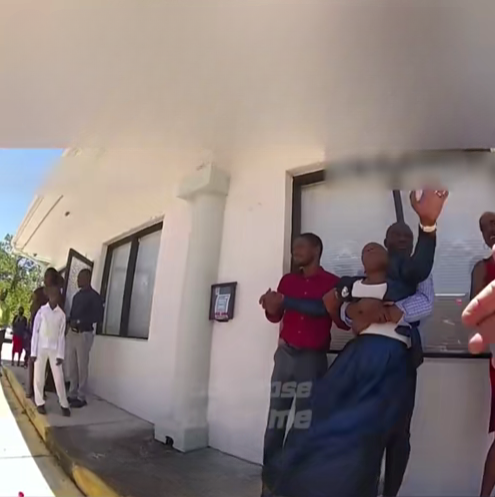
A Sunday that should have been filled with faith and family ended in tragedy when a baby was discovered lifeless inside an overheated car while the parents were attending church.
What was meant to be a Sunday of faith and family turned into an unimaginable nightmare when a baby was discovered lifeless inside a sweltering hot car while the parents attended church. The incident has left the local community reeling and sparked a national conversation about child safety, parental responsibility, and the dangers of leaving children unattended in vehicles.
The Scene of the Tragedy
According to authorities, the incident occurred in the parking lot of a suburban church, where temperatures inside the vehicle reportedly soared well above 120°F. Even on a seemingly warm day, parked cars can heat rapidly, creating an environment that becomes lethal for children within minutes.
Witnesses described the chilling aftermath. The mother collapsed in grief, screaming for help and desperately calling out for her child, while fellow churchgoers rushed to console her. Bodycam footage from first responders, released in part to the press, captures the moment vividly—the raw anguish of a parent who realized the unimaginable had happened. The grief and horror felt by those present resonated beyond the church grounds, leaving the community in shock.
The father, according to reports, was inside the church during the service and reportedly unaware of the extreme conditions inside the vehicle until it was too late. Emergency personnel attempted to resuscitate the infant, but the child was pronounced dead at the scene. Investigators noted multiple warning signs of heatstroke, a preventable cause of death when children are left in hot vehicles.
How Quickly Temperatures Rise in Cars
Experts emphasize that the tragedy could have been avoided entirely. Research shows that the interior temperature of a parked car can rise by nearly 20°F in just ten minutes, even with windows slightly open. On a 75°F day, the inside of a car can exceed 100°F within half an hour. For infants and toddlers, whose bodies cannot regulate temperature as efficiently as adults, even brief exposure to these extreme conditions can be fatal.
Dr. Linda Martinez, a pediatrician and child safety expert, explains, “Children’s bodies heat up three to five times faster than adults. That means what may feel like a mild day to a parent can quickly become a life-threatening environment for a baby in a car. The tragic reality is that it takes only a few minutes for irreversible damage to occur.”
Warning Signs of Heatstroke in Children
Recognizing early signs of heatstroke can sometimes save lives. Children left in hot vehicles may display the following symptoms:
- Red, hot, or flushed skin
- Rapid breathing or panting
- Lethargy or unusual sleepiness
- Vomiting or dizziness
- Irritability or inconsolable crying
Dr. Martinez stresses, “If a parent or caregiver notices any of these symptoms, immediate action is critical. Moving the child to a cooler environment and calling 911 can mean the difference between life and death.”
Statistics Highlighting the Danger
According to the National Highway Traffic Safety Administration (NHTSA), an average of 37 children die in the U.S. each year due to heatstroke in vehicles. This number has remained alarmingly consistent, despite widespread public awareness campaigns. Experts attribute many of these deaths to forgetfulness, distractions, or the mistaken belief that briefly leaving a child unattended is safe.
The tragedy at the church underscores these statistics and serves as a painful reminder that even a few minutes of inattention can have irreversible consequences.
The Human Cost Beyond Statistics
While statistics provide context, the emotional impact of incidents like this extends far beyond numbers. Families, friends, and community members are left grappling with grief, guilt, and anger. The parents involved in this incident now face a life-altering loss, and their children’s future will forever be shaped by this day.
Community leaders have expressed sorrow and support for the grieving family. Reverend Mark Ellison, a local pastor, said, “This is a devastating moment for everyone involved. We must come together as a community to support this family and also to ensure that such a tragedy never happens again.”
Social Media Outrage and the Public Response
In the wake of the incident, the story quickly spread across social media platforms. Many expressed shock, anger, and disbelief that such preventable tragedies continue to occur. Hashtags advocating child safety and stricter laws regarding leaving children unattended in vehicles quickly began trending.
Some users called for harsher penalties for parents who leave children in cars, while others emphasized education and awareness campaigns as a more constructive approach. The debate highlights the ongoing tension between accountability and understanding that human error can happen, even when parents love their children.
Preventive Measures for Parents and Caregivers
Experts agree that prevention is key to avoiding heat-related tragedies. The following strategies can help ensure children remain safe:
1. Never Leave a Child Unattended
No matter how brief the errand, leaving a child in a parked vehicle can be deadly. Even experienced parents can be distracted, but making the choice to take the child with you or leave them in the care of another responsible adult is crucial.
2. Use Reminders and Alarms
Technology can help reduce forgetfulness. Setting phone alarms, placing an item such as a diaper bag in the back seat, or using car seat reminders can serve as critical prompts to ensure a child is never accidentally left behind.
3. Educate Others
Family, friends, and childcare providers should be educated about the dangers of heatstroke and the importance of never leaving a child alone in a car. Community awareness programs and safety workshops can reinforce these life-saving messages.
4. Take Advantage of Community Resources
Some communities have installed public service alerts, such as dashboard warning stickers or educational campaigns at schools and daycares, highlighting the risk of leaving children in vehicles. Parents are encouraged to take these resources seriously.
5. Emergency Preparedness
Even with precautions, emergencies can happen. Knowing the symptoms of heatstroke, having a plan to call 911 immediately, and understanding first-aid measures for heat-related illness are essential.
Legal Implications
In many states, leaving a child unattended in a hot vehicle can lead to criminal charges ranging from negligence to manslaughter. While the primary focus is always on child safety and prevention, authorities also consider the legal ramifications to ensure accountability and deter future incidents.
Legal experts note that charges are highly dependent on the circumstances, such as the child’s age, duration left alone, and parental intent. Regardless, the emotional and legal consequences for families are severe and lasting.
Community Support and Counseling
Following tragedies like this, communities often come together to provide support. Counseling services, grief support groups, and faith-based organizations play a critical role in helping families navigate their loss. Experts stress that addressing the emotional trauma is as important as highlighting preventive safety measures.
The Role of Churches and Public Spaces
The recent incident took place in a church parking lot, a location that many would consider safe and community-oriented. Experts suggest that religious and public institutions can play a role in promoting child safety. This might include:
- Displaying warning signs about the dangers of leaving children in cars
- Hosting safety workshops for parents
- Encouraging family-friendly policies that allow infants and young children to attend services
Such initiatives can raise awareness and potentially prevent similar tragedies in the future.
Expert Commentary
Child safety advocates stress that education, awareness, and technology can significantly reduce the risk of vehicle-related heatstroke.
“Parents are often juggling multiple responsibilities, but the bottom line is simple: a child should never be left alone in a vehicle,” says Dr. Emily Chan, a pediatric health specialist. “One moment of distraction can turn into a lifetime of regret. We must use every tool available to keep our children safe, from reminders and alarms to community education.”
A National Conversation on Child Safety
The tragedy has sparked a broader dialogue about child safety in the United States. While awareness campaigns exist, experts believe that more aggressive public education, stricter laws, and proactive community engagement are necessary to prevent such incidents.
Organizations like Safe Kids Worldwide and the National Highway Traffic Safety Administration continue to promote life-saving messages, urging parents to treat any parked vehicle as a potential hazard.
Moving Forward
As the community grieves, the hope is that this tragedy can serve as a catalyst for change. Parents, caregivers, religious institutions, and lawmakers can work together to ensure that no child loses their life to preventable heatstroke again.
This heartbreaking incident serves as a sobering reminder that, even in places of comfort and faith, dangers can lurk. Awareness, vigilance, and preventive measures are essential for protecting the most vulnerable members of society: our children.
Conclusion
The loss of a child in a parked car is a preventable tragedy that leaves an indelible mark on families and communities. This recent incident at a church highlights the urgent need for awareness, caution, and community support. By understanding the risks, taking proactive steps to ensure children’s safety, and promoting educational outreach, we can work toward a future where such heartbreaking events no longer occur.
Parents and caregivers must remember: a few minutes of inattention can cost a lifetime. The responsibility of keeping children safe is paramount, and the lessons from this tragedy must resonate across communities nationwide.



